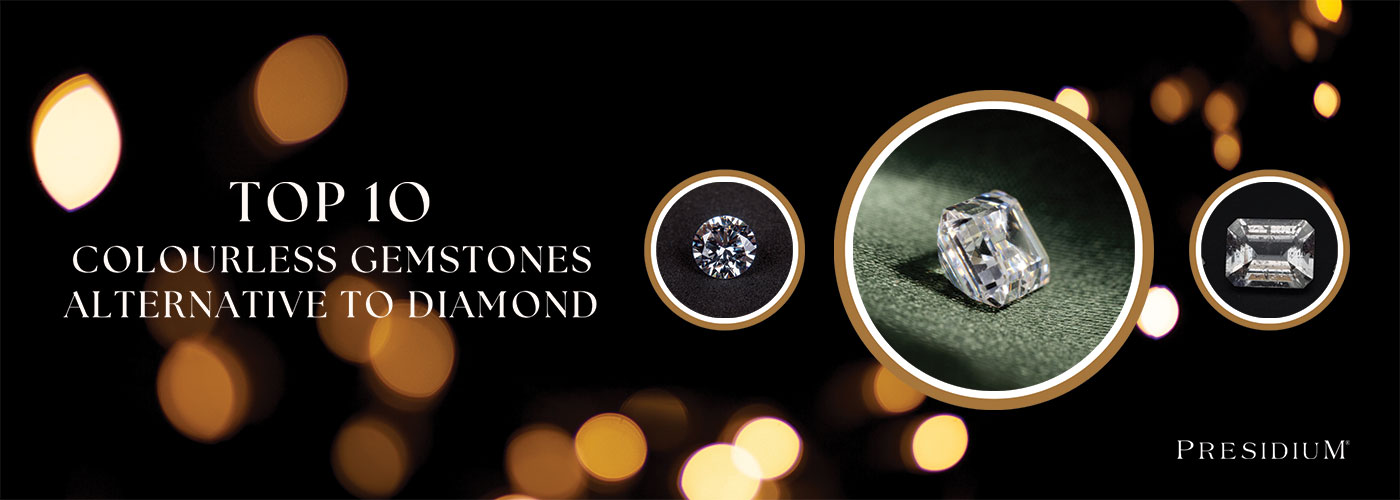
Just like durians are king of the fruits and lions are king of the jungle, diamonds are probably considered to be the king of gems. There is a long history (culturally and industrially) behind diamonds and this history became one of the basis for the value of diamonds.
When we think about diamonds, we probably remember the 4C quality grading of diamonds: carat, clarity, colour, cut. And we all know the “colour” grading of diamonds are classified into two categories: colourless and fancy colour. Even in the colourless range, there is a whole lot of different terms to describe the colourless colour (pun intended).
In this article, we will not actually dive into the colour of the colourless gem. Instead, we shall discuss other colourless stones that do not have colour grading and yet can be rare and beautiful as well.
Let’s have a quick look at natural colourless diamonds and its properties:
- Historically, the first colourless diamonds were found in India.
- The largest colourless diamond found so far is “The Cullinan Diamond”, weighing 3,106.75 carats (or 621.35 grams). It was found in Cullinan, South Africa, Premier Mine II in 26 January 1905.
- Main chemical composition is carbon ( C ) with trace elements, nitrogen or boron that may give a tint of yellow, brown, green or blue.
- Most natural colourless diamonds are classified under Type Ia, 1b and Type IIa.
- Natural colourless diamonds can give a 415nm absorption band under the prism spectroscope, or the UV-VIS absorption spectrum.
- It is a single refractive material, classified under the cubic crystal system.
- Its lustre is described as “adamantine”. This is due to its hardness of 10 on Moh’s hardness scale.
- Natural white diamonds (and other fancy coloured diamonds) are good conductors of heat and blue diamonds (with boron as trace elements) are good conductors of electricity as well.
- They are grease loving and can be sorted out using a grease belt.
- Natural diamonds have an international price list, Rapaport Report, for traders to have a guideline on trading trends and prices.
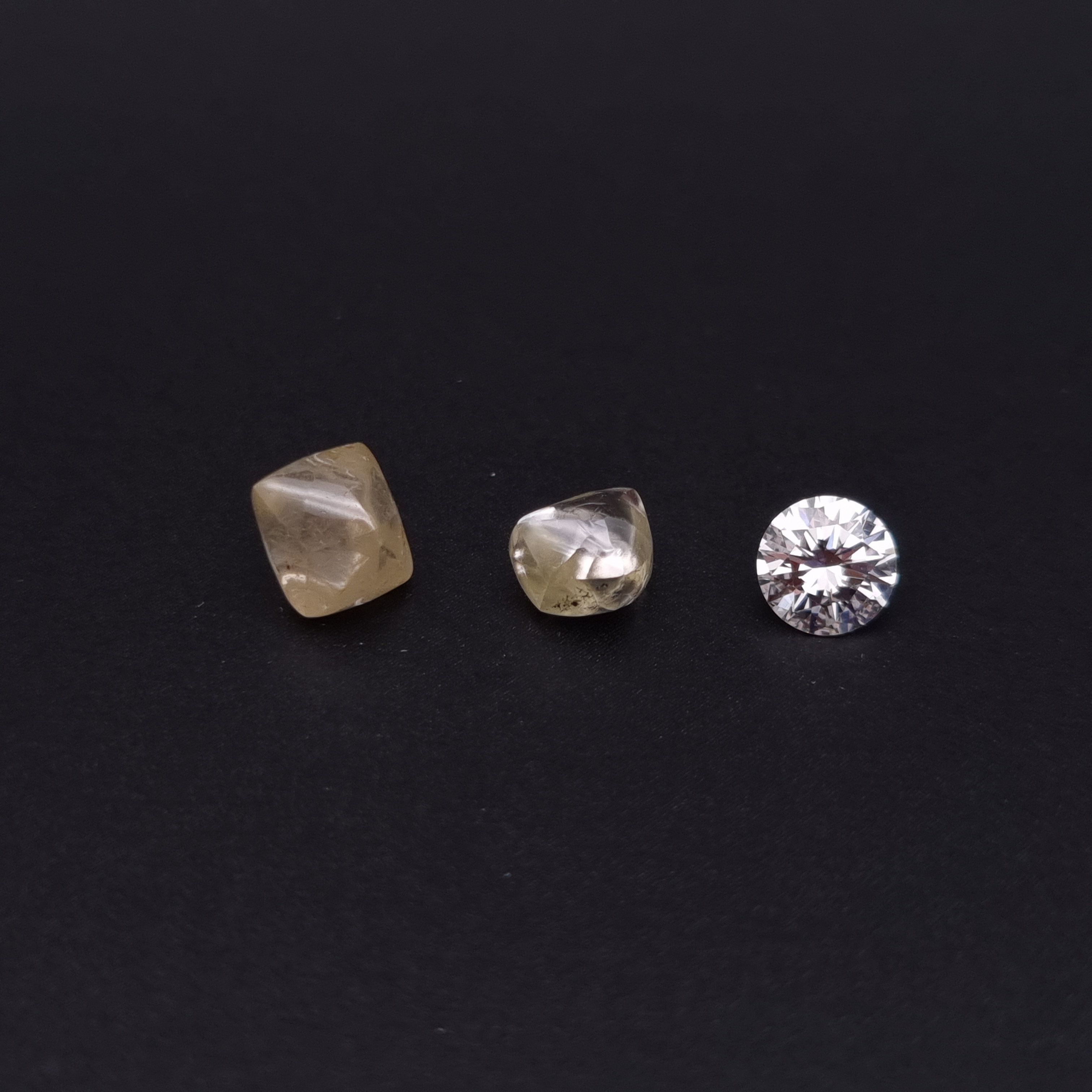
From left to right: 1.82ct natural rough diamond with an octahedral crystal shape from Kalimantan, Indonesia; 1.17ct natural rough diamond with a flattened hexa-octahedron crystal shape from Phuket, Thailand; 0.55ct natural polished diamond, J colour and SI1 clarity.
Following are the top 10 colourless gem alternatives to diamonds that we have picked out for the avid jewellery designers, jewellers, and collectors!
Also known in the trade as lab-grown or man-made diamonds, they have the same physical, optical, and chemical properties as the natural diamonds. The only difference is that synthetic diamonds are made in a laboratory under stable conditions with advanced technologies, while natural diamonds are created under the rigorous environment of the upper mantle billions of years ago. There are two methods of synthesizing diamonds: by High Pressure High Temperature (HPHT) method, and by Carbon Vapour Deposition (CVD). Synthetic diamonds can come in a variety of colours, in particular yellow, pink and blue. The colour can be acquired through doping the material with colouring elements such as nitrogen or boron, or the synthesized diamonds can be further treated through the HPHT and irradiation process.
 |
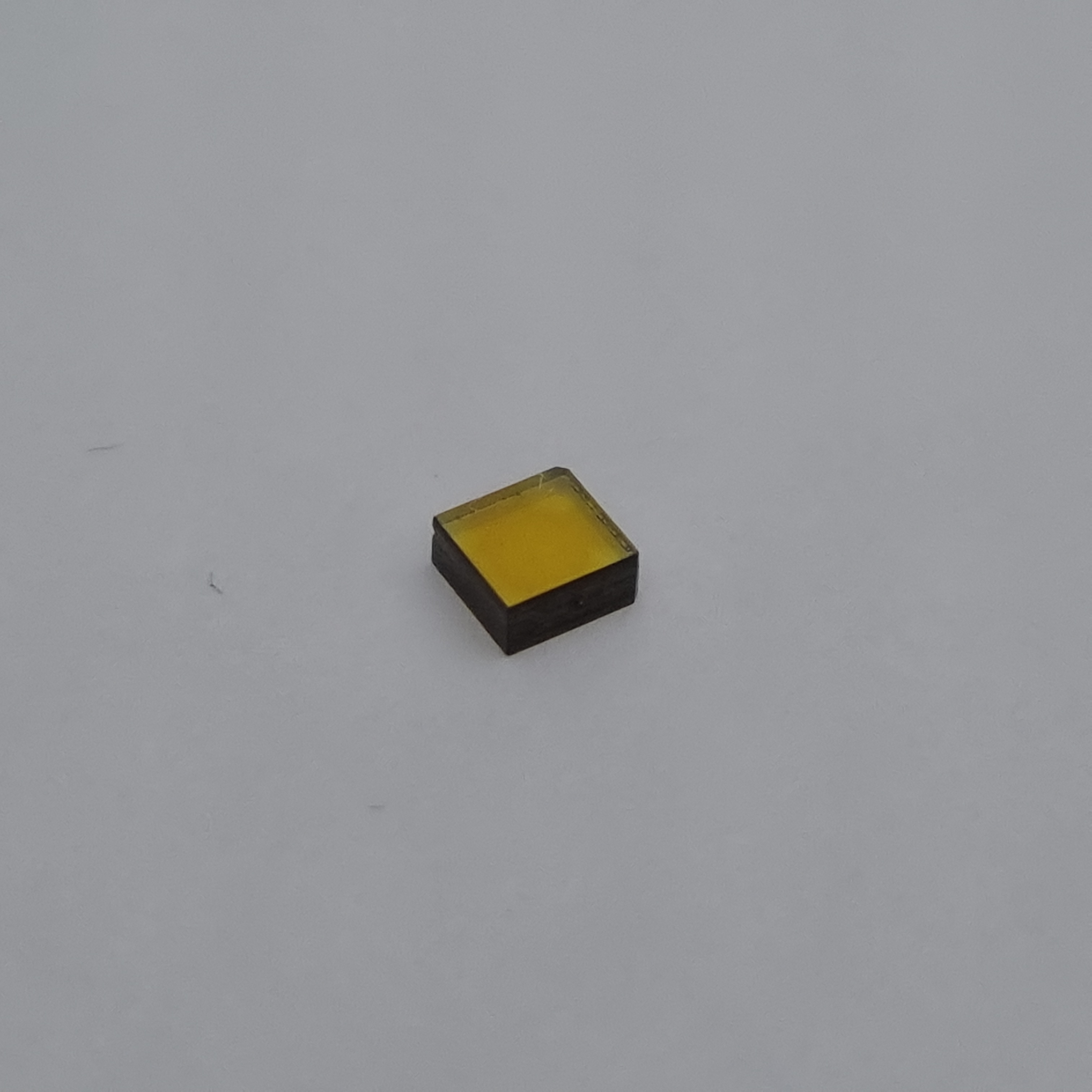 |
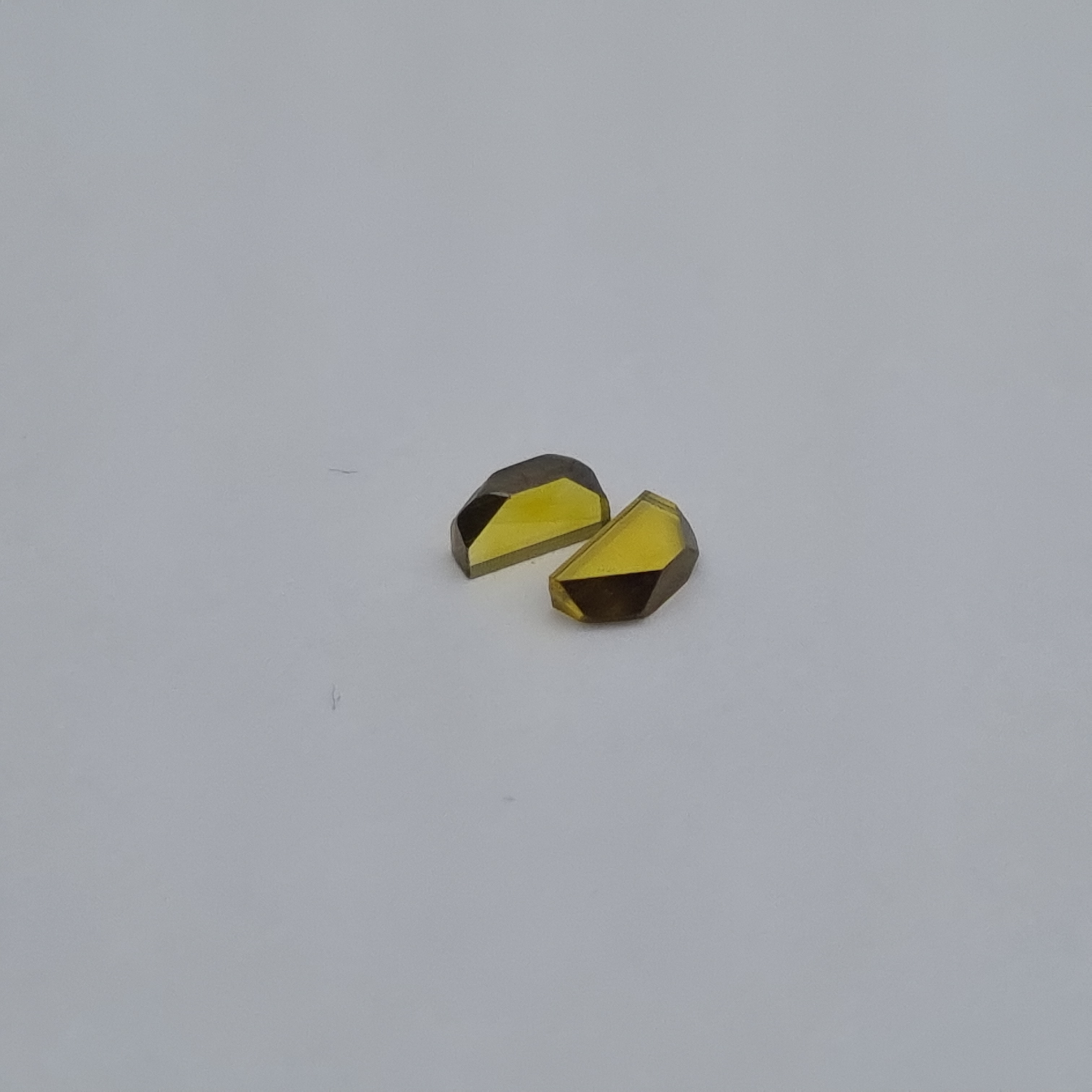 |
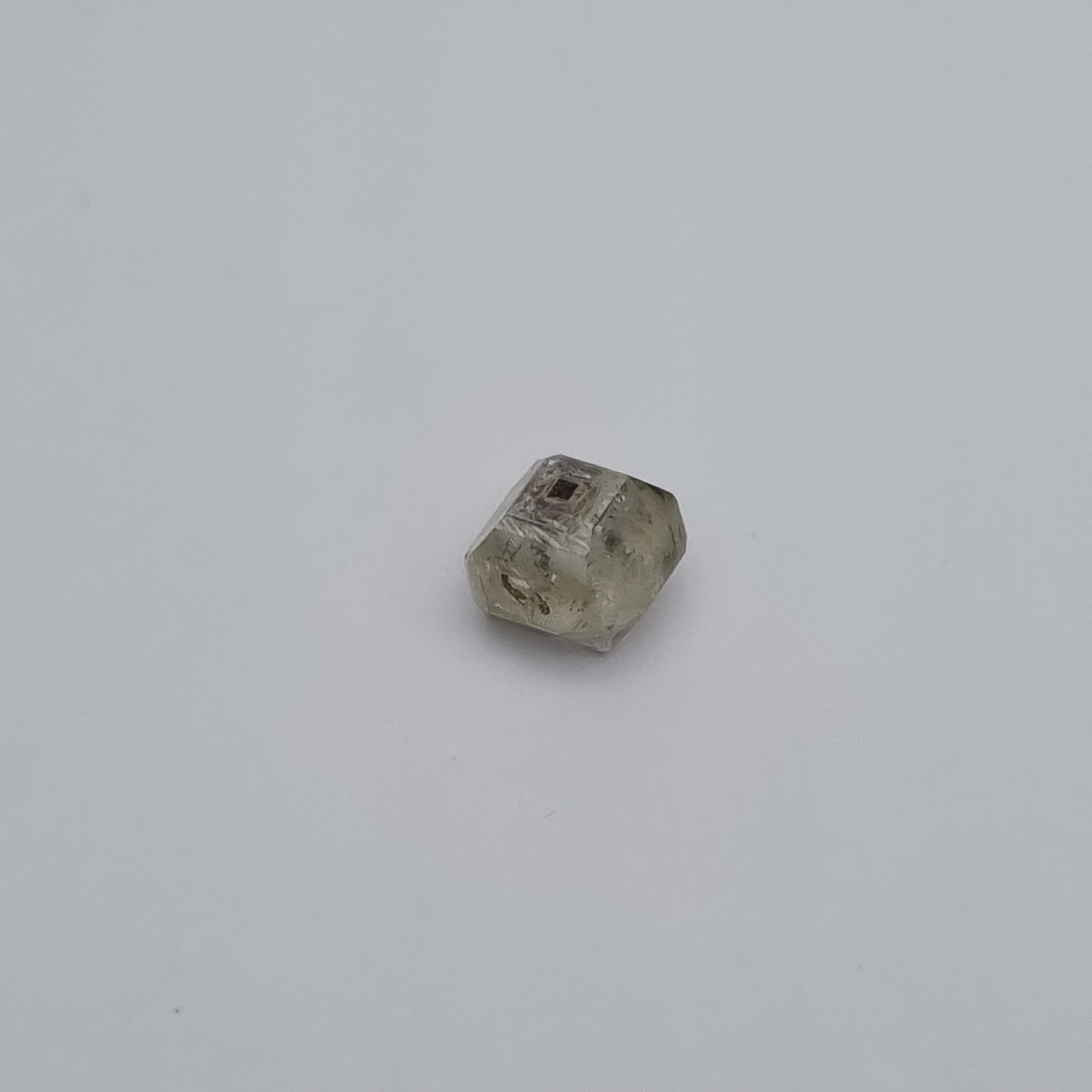 |
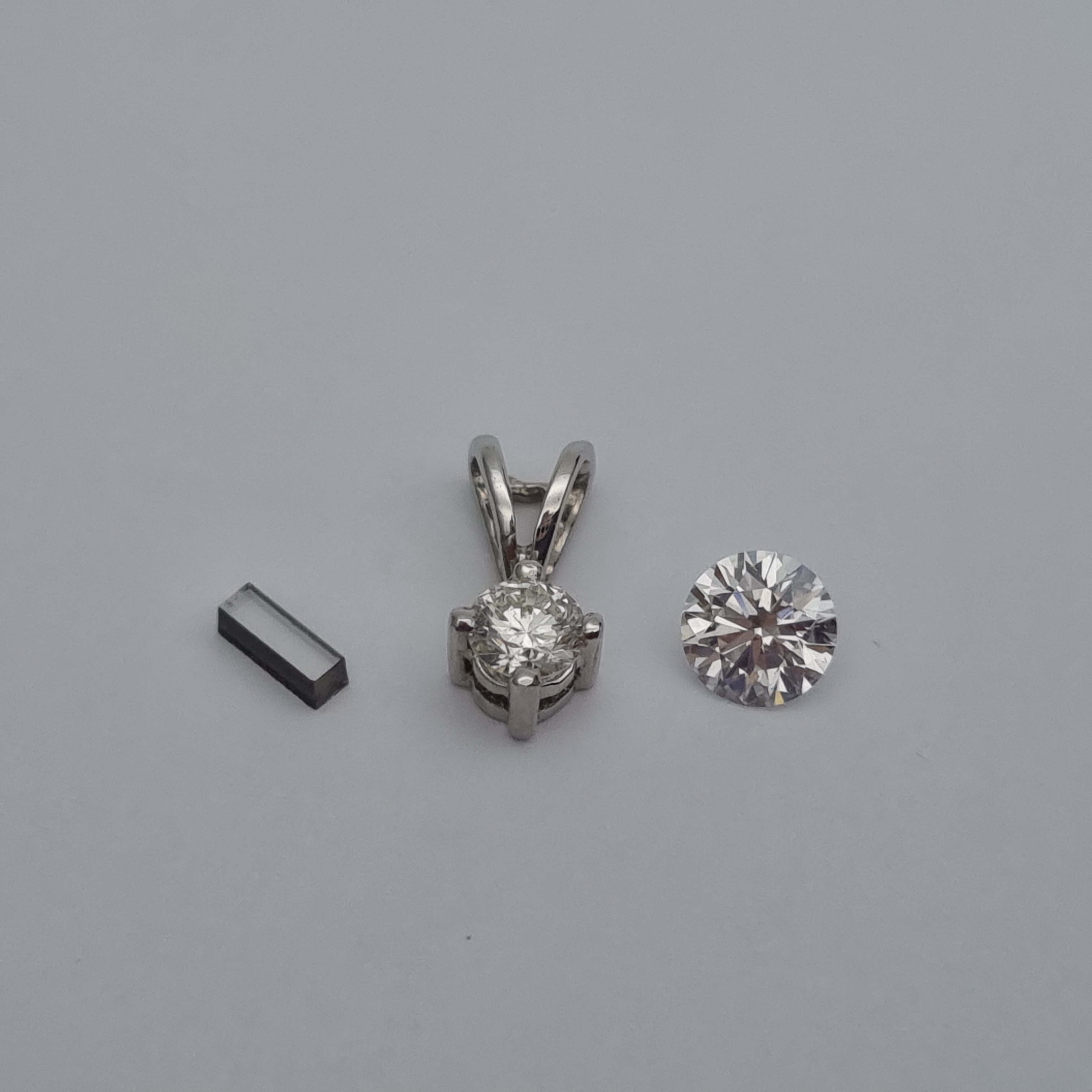 |
|
A HPHT synthetic diamond (0.37ct) acquired by Far East Gem Institute, Singapore, in 1995. At that time, colourless synthetic diamonds were a rarity. |
A rough HPHT synthetic diamond (0.19ct) manufactured by Sumitomo. Acquired by Far East Gem Institute, Singapore, in year 2000. | A pair of rough HPHT synthetic diamonds (total weight 0.26ct) manufactured by De Beers. Acquired by Far East Gem Institute, Singapore, in year 2000. | A rough synthetic diamond (0.87ct) manufactured in Russia, consisting of metallic inclusions that is also magnetic in nature |
From left to right: A type IIa CVD synthetic diamond rough (0.125ct); A CVD synthetic diamond pendant set in 18k white gold, manufactured in China (2015); A type IIa CVD synthetic diamond polished (0.36ct) with quality E colour and VVS clarity. |
Moissanite, or silicon carbide, is one of the most convincing diamond simulants in the market. Originally created by accident in 1890, it was soon discovered to be an extremely rare natural mineral in 1893 by Henri Moissan. Before there were difficulties distinguishing synthetic moissanite apart from diamond due to their relatively similar heat conductivity. The hardness, lustre and dispersion of synthetic moissanite is also very similar to diamonds. Today, virtually all moissanites in the market are synthetic, and can be easily told apart by handheld devices like Presidium’s Multi-Tester.
 |
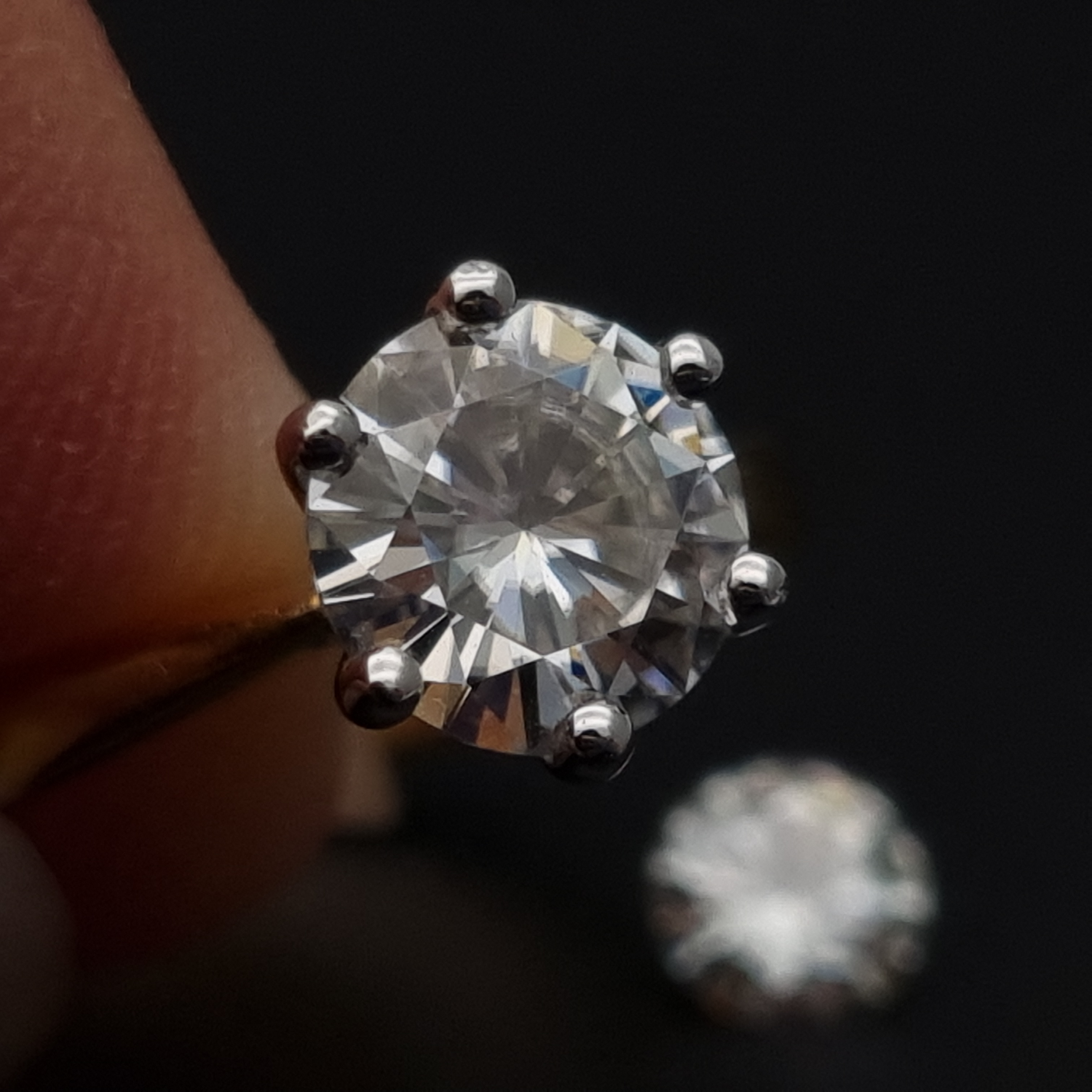 |
||
|
|
Left: A synthetic moissanite equivalent to a 1 carat sized diamond, set in an 18K gold ring. Right: 0.27ct polished synthetic moissanite. |
|
When observed under microscope or 10x lens, the synthetic moissanite will show a doubling effect along its facet edges. This is due to the optical character of synthetic moissanite, which is anisotropic. The doubling effect observation can also help us differentiate synthetic moissanite from CZ or diamonds, as both CZ and diamonds are optically isotropic. |
Only entered the market about 50 years ago, CZ’s main purpose was to simulate diamond. Cubic zirconia was first manufactured in Russia, hence its misnomer “Russian Diamonds”. Its primary ingredient in fact, is extracted from natural zirconium mineral ores, mainly zircon, through skull-melting method. Fairly easy to manufacture, CZ now populates the costume jewellery industry with its multi colours, diamond-like appearance, and befittingly low price. In more recent years, the quality and cut of CZ has improved a lot and even has a cut grading system. CZ can come in a variety of colours as well.
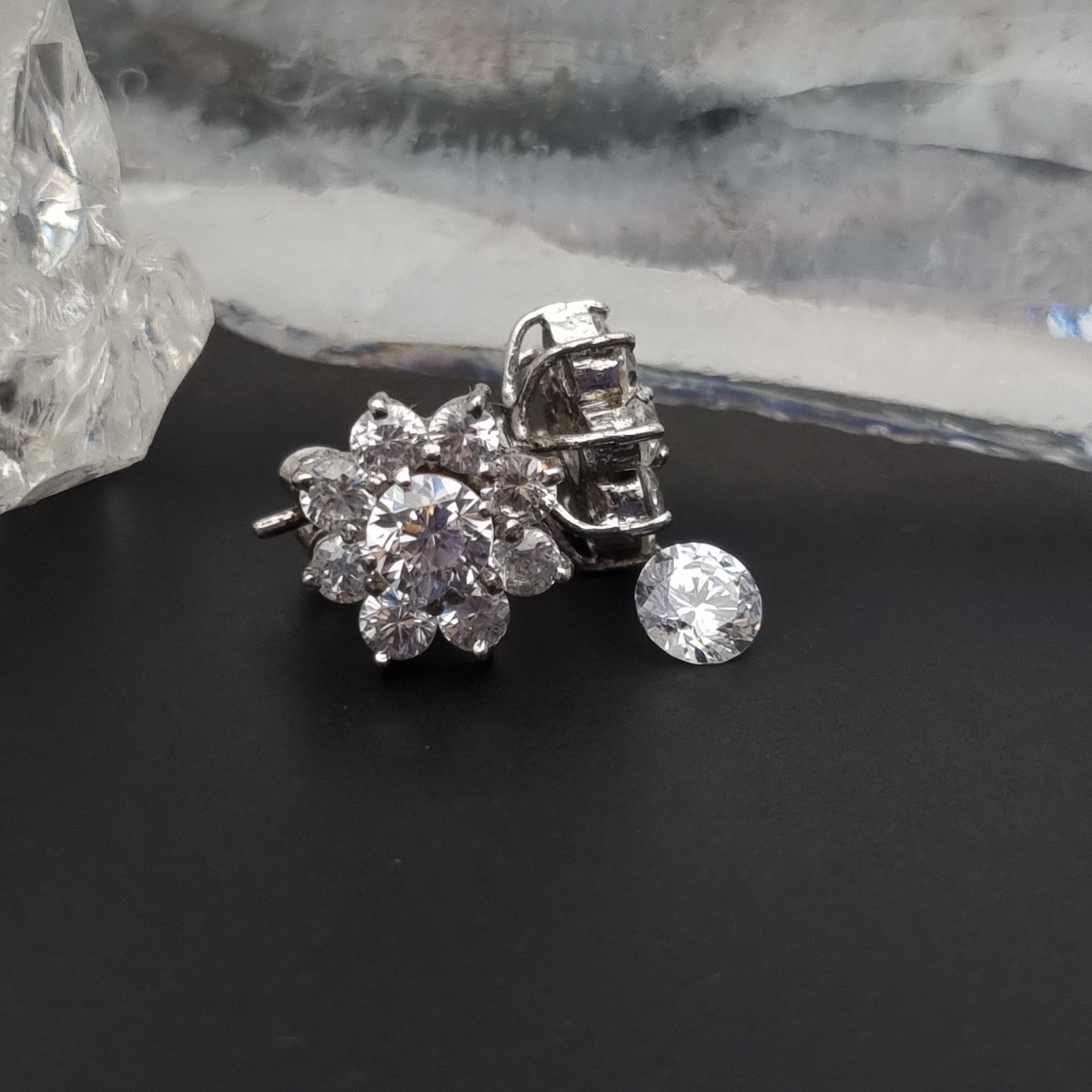 |
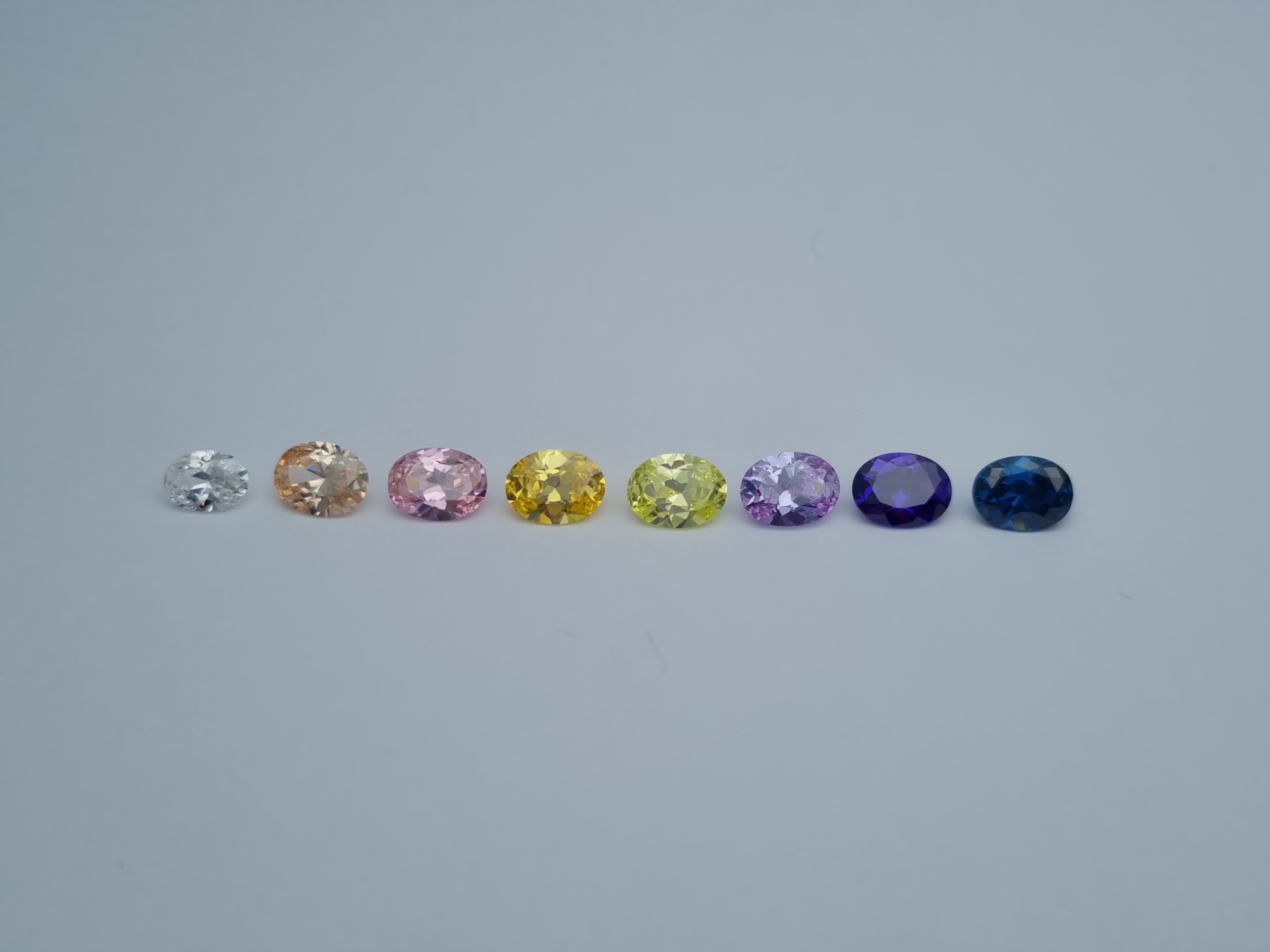 |
|||
|
A pair of earrings with cubic zirconia set in silver. The white pieces of materials in the background are the rough materials of cubic zirconia. |
|
8 pieces of cubic zirconia in the range of 1.22 ct to 2.10ct, in a variety of colours. |
Commonly misinterpreted as CZ, but unlike CZ, zircon is a natural earth-made mineral. Often found in a colourless form, it possesses a high dispersion rate that produces “fire” that mimics a diamond. However, colourless zircon appears fuzzy due to its strong double refraction that causes double images of facets, known as doubling effect. Zircons can come in a variety of colours as well!
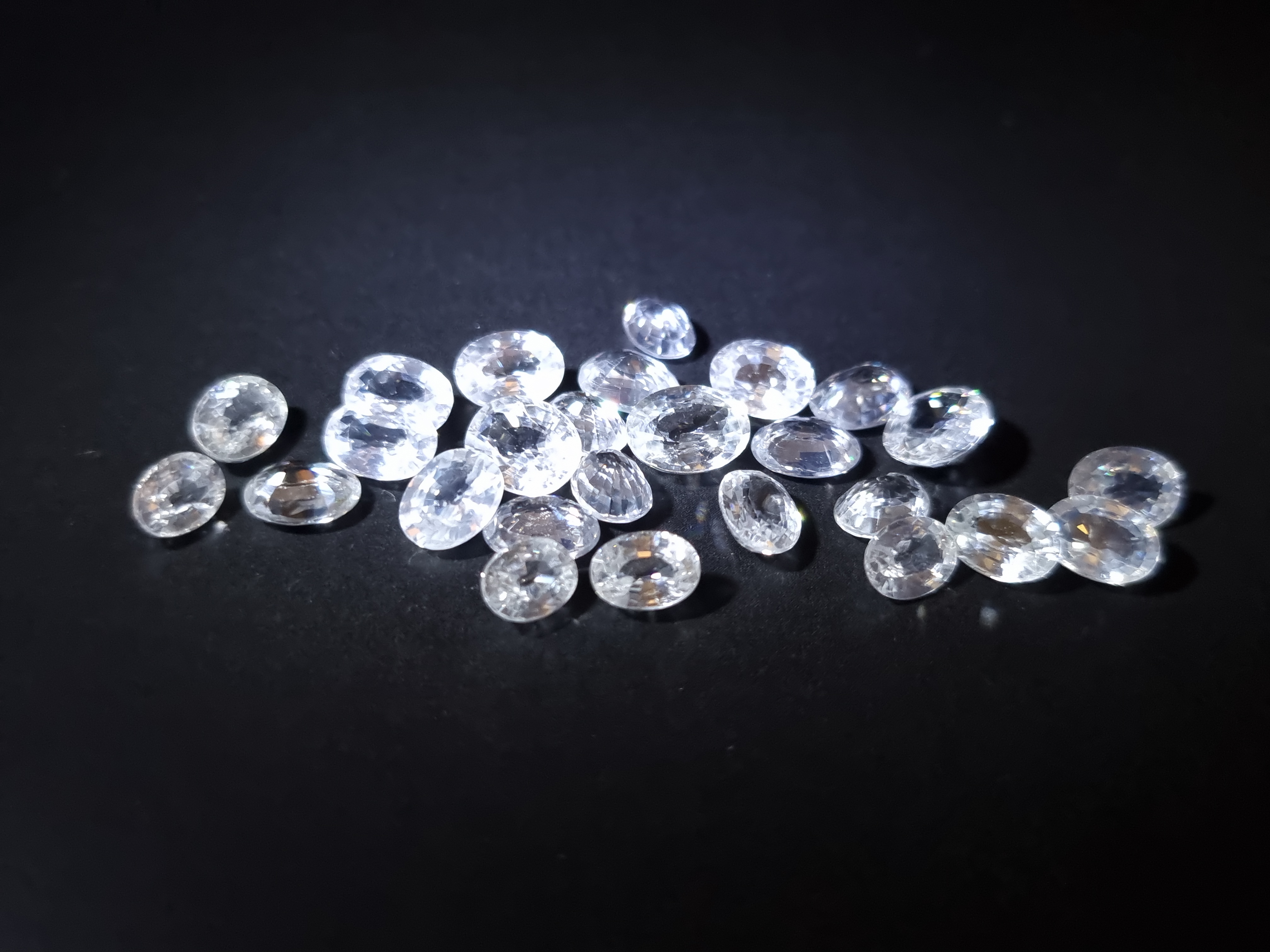
Typically known for its saturated blue, it comes in many other colours due to different trace elements such as iron, titanium, vanadium, or chromium. Its famous red variety is actually ruby, with trace elements of chromium and/or vanadium. As for white sapphires, along with any other colourless natural gemstones, it comes in a pure chemical composition without additional trace elements. That means that white sapphire is a pure mineral of aluminium oxide. Sometimes white sapphires are used as alternatives to white diamonds for the side stones in a piece of jewellery.
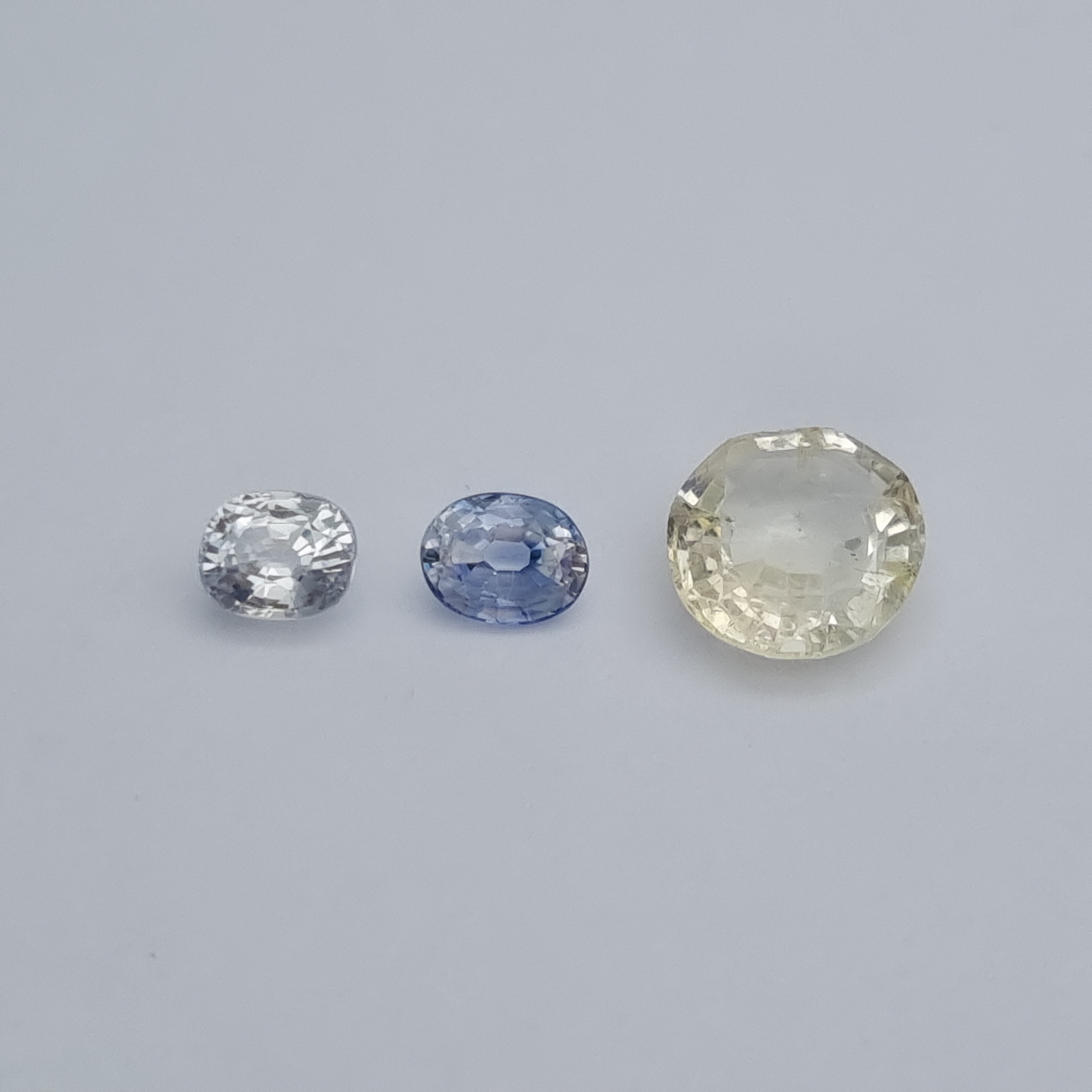 |
 |
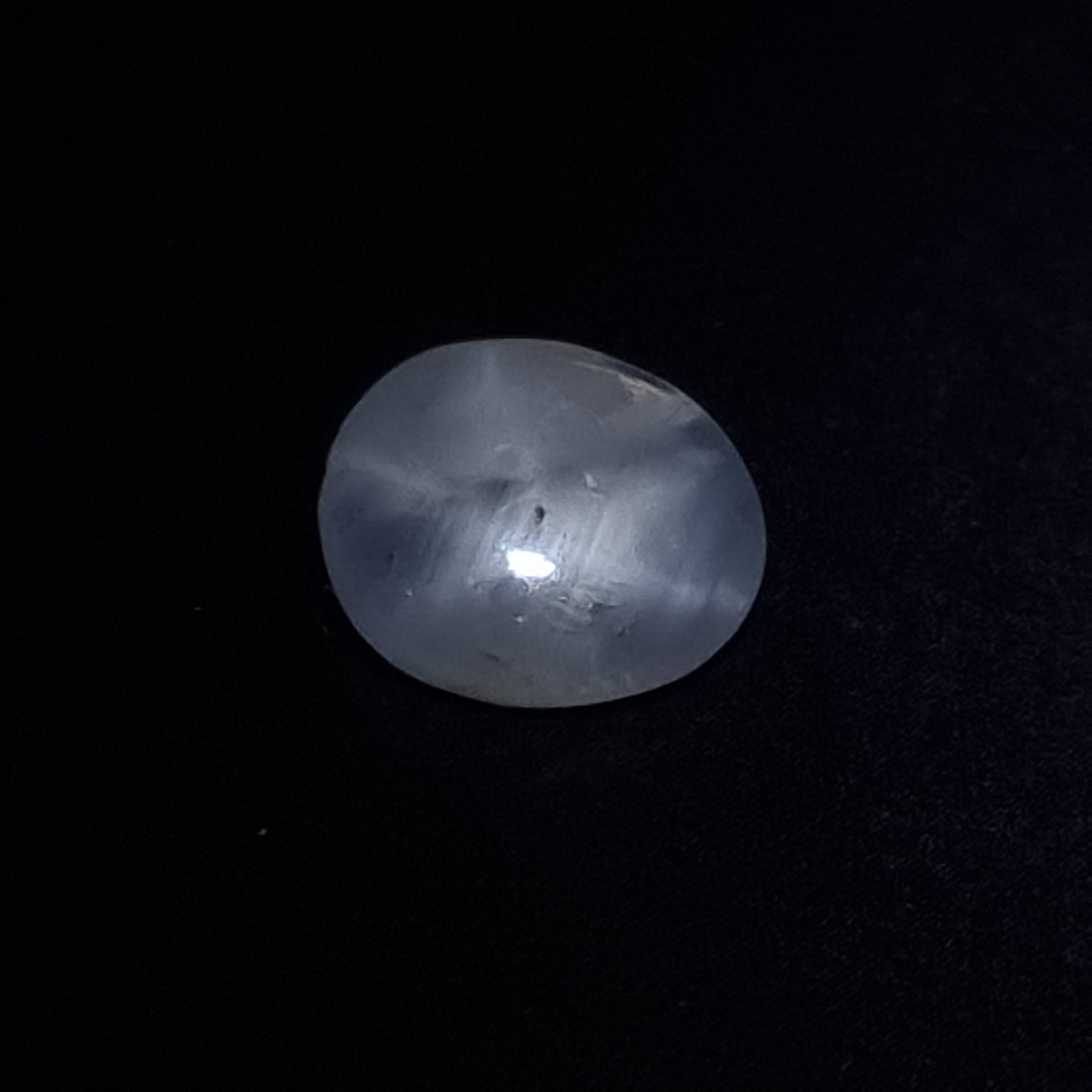 |
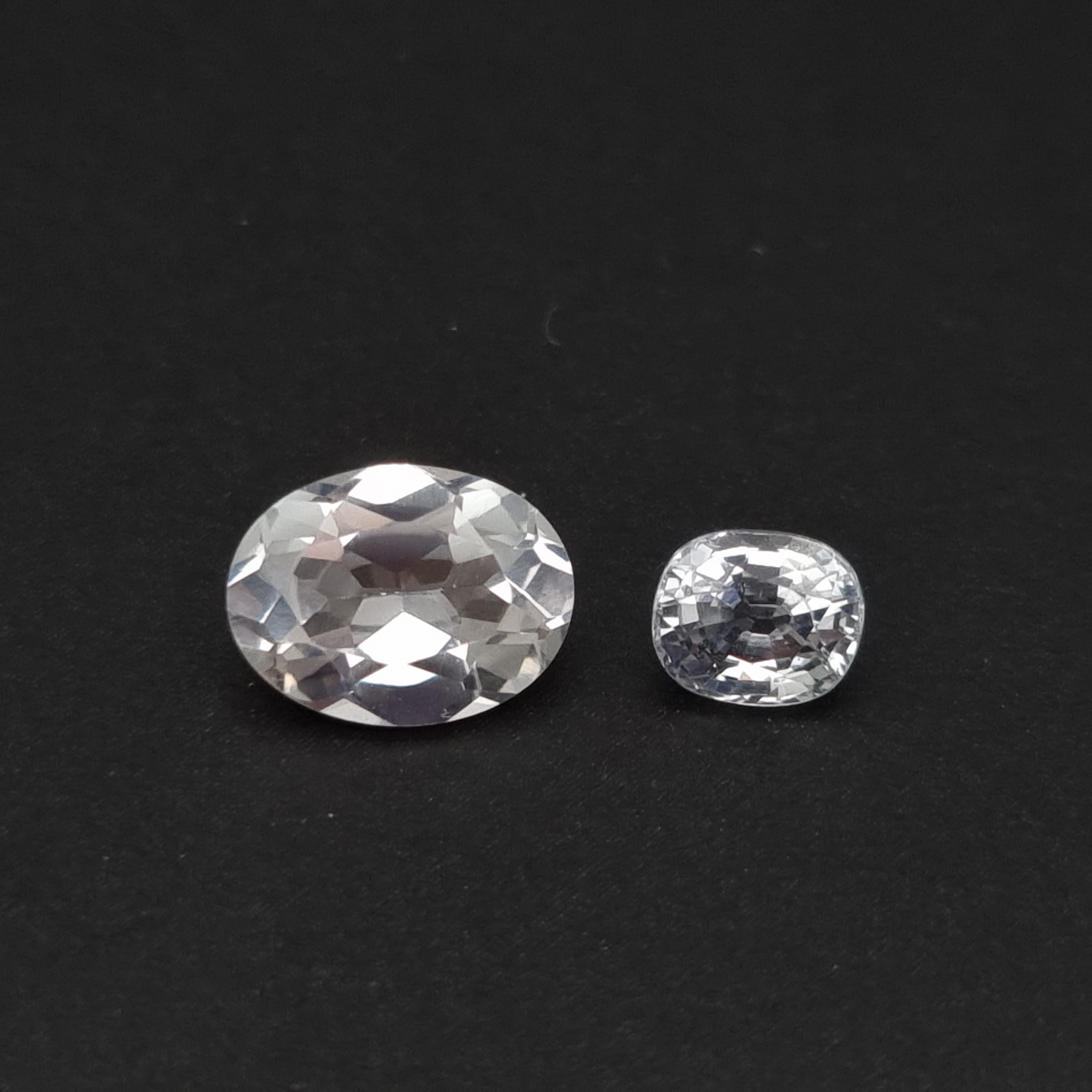 |
|||
|
Left to right: Near colourless natural sapphire (0.61ct); Light blue natural sapphire (0.57ct); Very light-yellow natural sapphire (2.19ct). In nature, trace elements are always there. Hence, in a way, a natural pure aluminium oxide mineral is considered rare. |
|
A natural colourless sapphire (2.48ct) cut en cabochon due to optical effects | A natural colourless 6-ray star sapphire. |
Left: A colourless synthetic sapphire (1.61ct); Right: Natural near colourless sapphire (0.61ct). It is easier to manufacture pure white sapphire in larger sizes than to find natural pure colourless sapphire in the market. |
Beryl is a mineral with a chemical composition of beryllium aluminium silicate. Probably better known for its famous and colourful varieties of emerald (green), aquamarine (greenish-blue), and morganite (pink), but little did we know that they used to be goshenites (white) before trace elements took over. Goshenite can come in large sizes of more than 10 carats, however, they are not commonly used as diamond simulants. The good thing is that this gem is not as costly as white sapphires and other lookalikes, and is unique on its own because of its association with the green variety (i.e. Emerald).
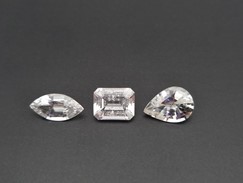 |
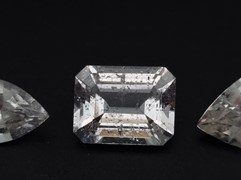 |
|
| 3 pieces of Goshenite (2.17ct marquise shape, 3.19ct emerald shape, 3.34ct pear shape). Goshenite tends to have some inclusions, however, it does not affect its beauty too much. | A close up look into the centre piece of goshenite. Under microscopic observation, you may find multiple two-phase inclusions in these gems! |
Topaz appears to be the hardest among the silicates at 8 on the Mohs hardness scale. They are very commonly found in a colourless state and yet seldom used in their original colour. Most colourless topaz are treated to various shades of blue as they are higher in demand. Nevertheless, topaz is still an affordable alternative for diamonds.
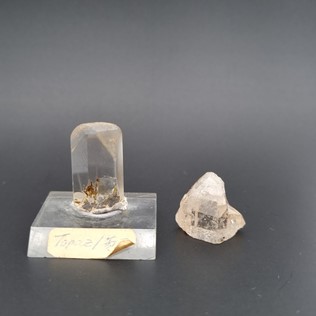 |
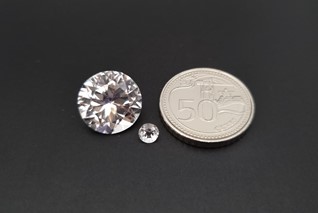 |
|
| Two pieces of rough uncut colourless topaz with an orthorhombic crystal shape. |
Two pieces of white topaz, 12.17ct and 0.44ct compared with a 50 cents coin. |
In terms of affordable diamond simulant, rock crystal quartz tops it all. Quartz or silica dioxide is one of the most abundant minerals on earth, and its uses range beyond in jewelleries. Its physical and chemical properties enable clear quartz to withstand physical and chemical weathering.
 |
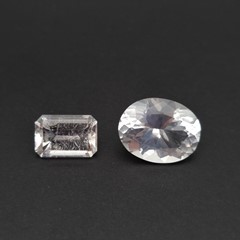 |
 |
||
| Natural clear quartz can come in large sizes. The large piece on the top right corner has a unique inclusion which shows a “twin”. |
Left: 2.38ct Emerald shape natural clear quartz; Right: 4.98ct oval mixed-cut natural clear quartz. Sometimes clear quartz can be crystal clear, but with some inclusions (left). Sometimes clear quartz can be rather free of inclusions, but is milky in appearance (right). |
This is a large piece of synthetic clear quartz, manufactured in Moscow. As natural clear quartz tends to be included, synthetic clear quartz may be used as an alternative. It is not easy to detect the difference between the natural ones and the synthetic ones especially if the gem is clear. |
Created in the 1950s and 1960s respectively, both are lab-grown and belong to the garnet group. Although primarily made to simulate diamond, they also come in an array of colours. Both gradually went out of fashion when CZ was introduced into the market. Not only that, the cost of production is also significantly higher than manufacturing CZ and synthetic moissanites. Although you still can find some specimens in the market, these materials are mainly used for optics, with a particular interest for high-power/high-energy laser systems.
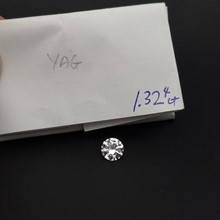 |
 |
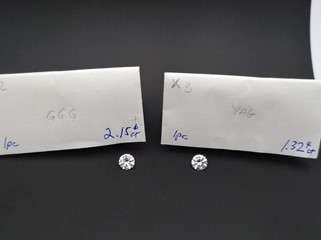 |
||
| A 1.32ct round brilliant cut YAG. | A 2.15ct round brilliant cut GGG. | Putting the two pieces together makes it very difficult to differentiate them. However, on careful observation, you will notice that YAG and GGG are brighter and clearer than most other diamond simulants/imitations/alternatives. |
To summarise the above…
Here’s a table to summarise the use of the above gems as alternatives to colourless diamonds:
| Synthetic Diamond | NEW and popular alternative to natural colourless diamonds |
| Synthetic Moissanite | Common alternative to diamonds |
| Cubic Zirconia | Common alternative to diamonds |
| White zircon | Common alternative to diamonds |
| White sapphire | Common alternative to diamonds |
| White beryl (Goshenite) | Good alternative for large sizes |
| White Topaz | Good alternative for large sizes |
| Rock Crystal (quartz) | Not a great replacement, but can be value for money |
| YAG | Not commonly used |
| GGG | Not commonly used |
This is not an exhaustive list of colourless gems you can find in the market. However, these are the more commonly known ones.
Bonus Reading
There are four more natural colourless gems that are unique!
As tourmalines form a large group of a mineral group, the coloured varieties are quite common. Hence, the rarer variety of tourmaline is the colourless tourmaline (known as Achroite which means “without colour” in Greek). As it is rare, it is hardly used as an imitation of a diamond. Not only that, it does not possess the brilliance and fire that diamonds possess. However, it is still a gem to look out for if you are looking for colourless gems!
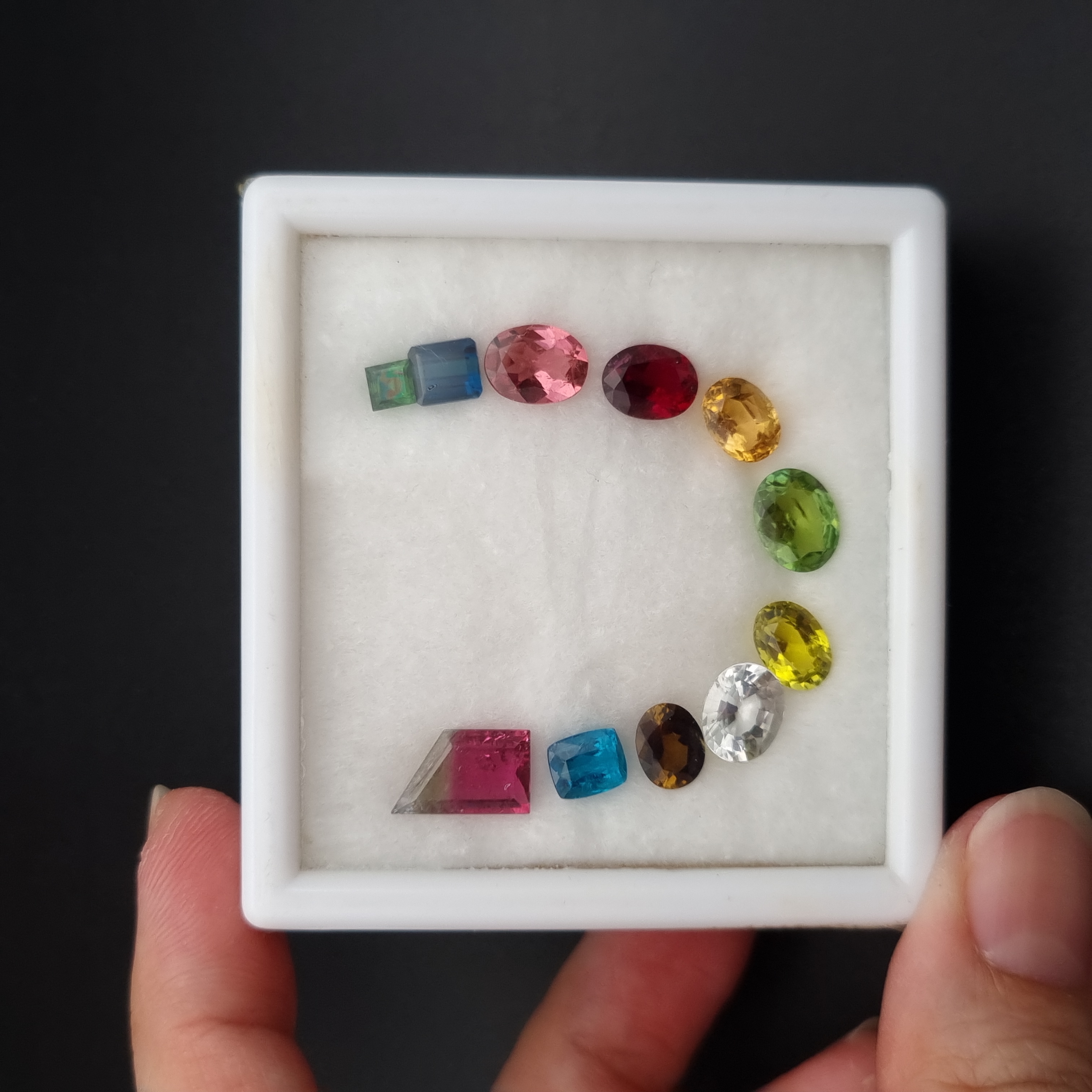 |
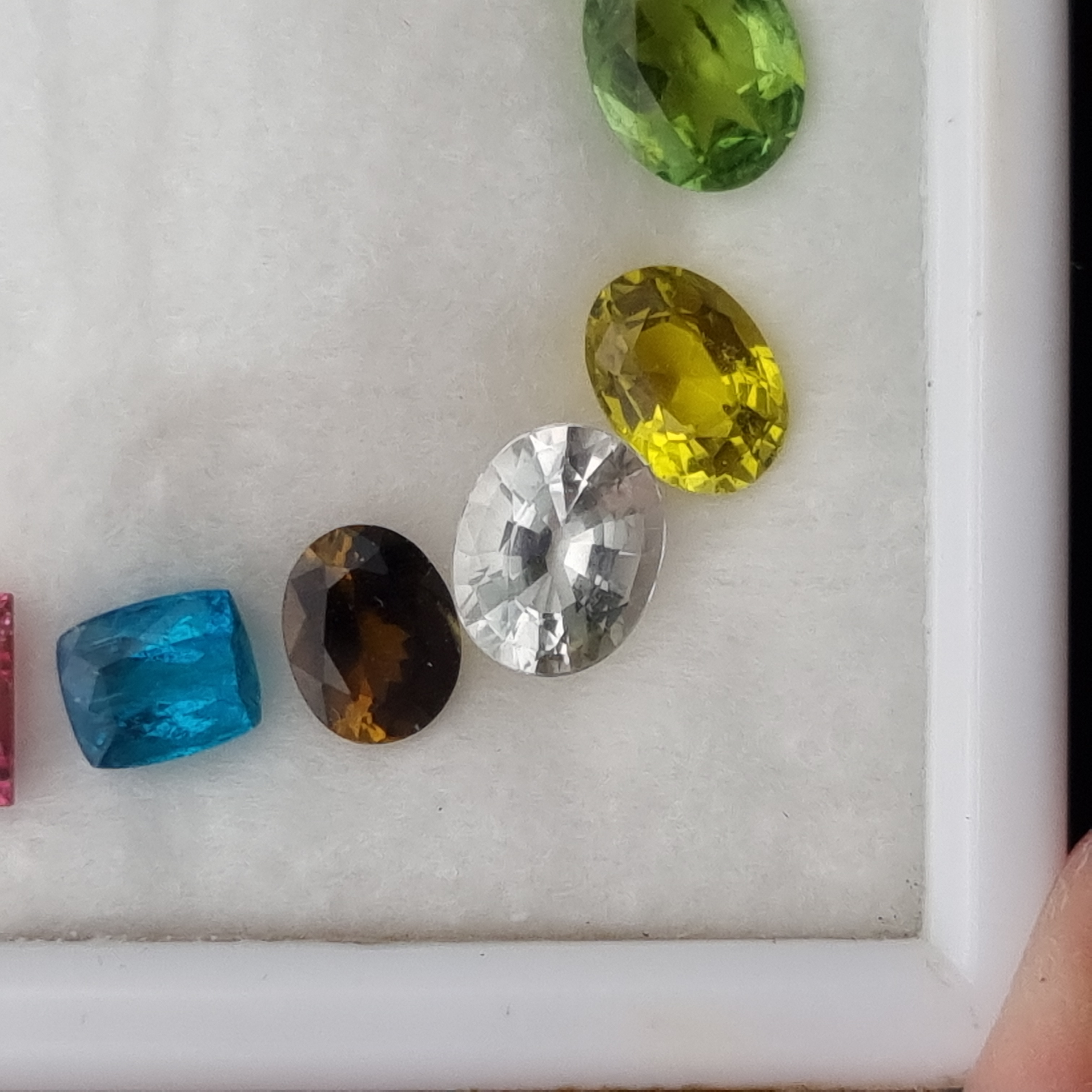 |
|
A box of tourmalines to represent the tourmaline group. This box includes watermelon tourmaline, paraiba tourmaline, rubellite, dravite, indicolite and chrome tourmaline. |
The white variety of tourmalines is considered rather rare amongst all the tourmalines and also other natural colourless gems. |
Phenakites have a chemical composition of Beryllium silicate. Its name in Greek means “deceiver”. (Perhaps because it looks like diamonds after polishing?) These gems can be found in Brazil, Mexico, Namibia, Norway, Zimbabwe, Sri Lanka, Tanzania, United States and Myanmar.
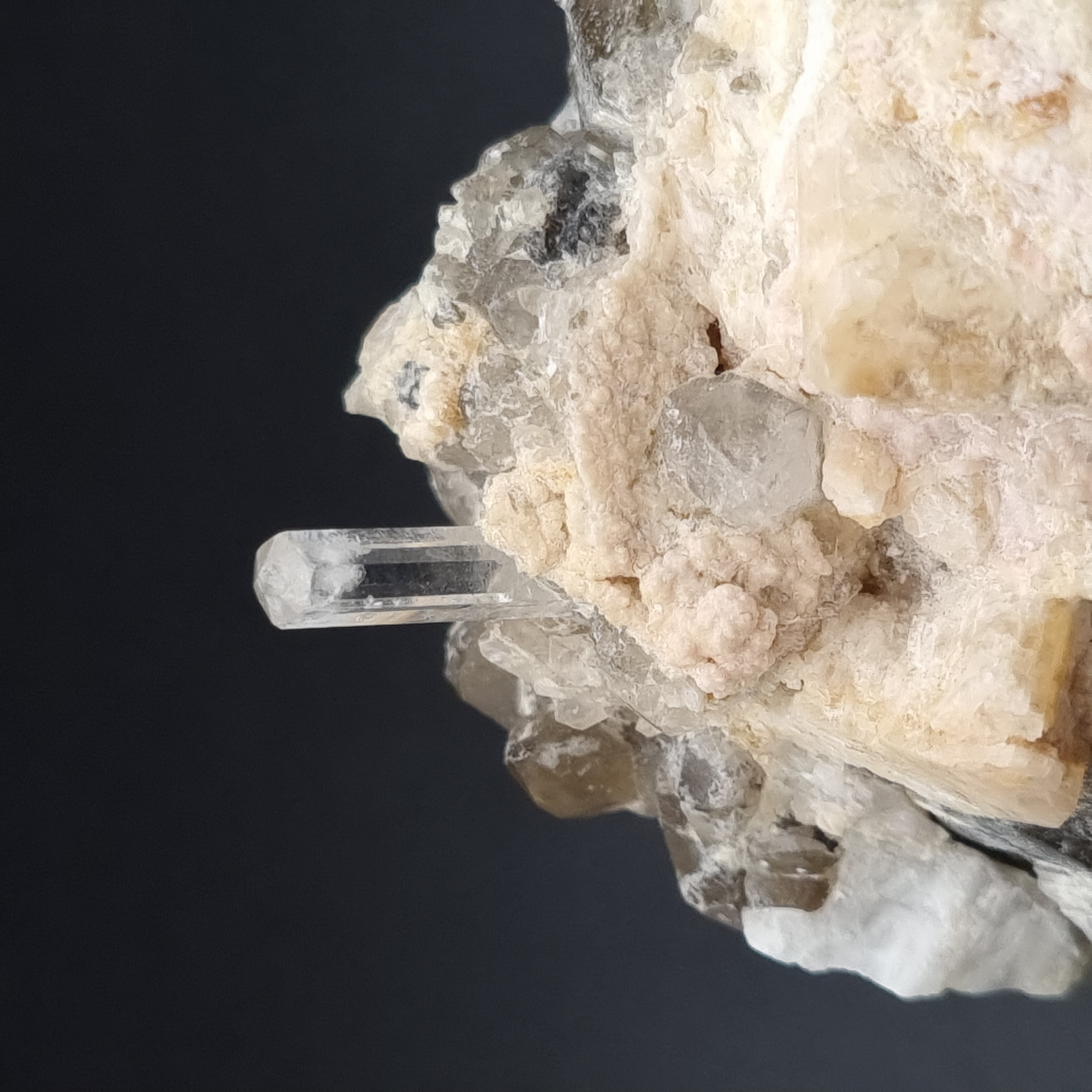 |
A phenakite with prismatic habit and hexagonal structure in a matrix of feldspar and quartz. |
Calcite comes in a variety of colours, such as pink, green, yellow. Its most unique feature is having a strong doubling effect. Calcite is also used in the prism spectroscope to create a spectrum of colours for gem testing.
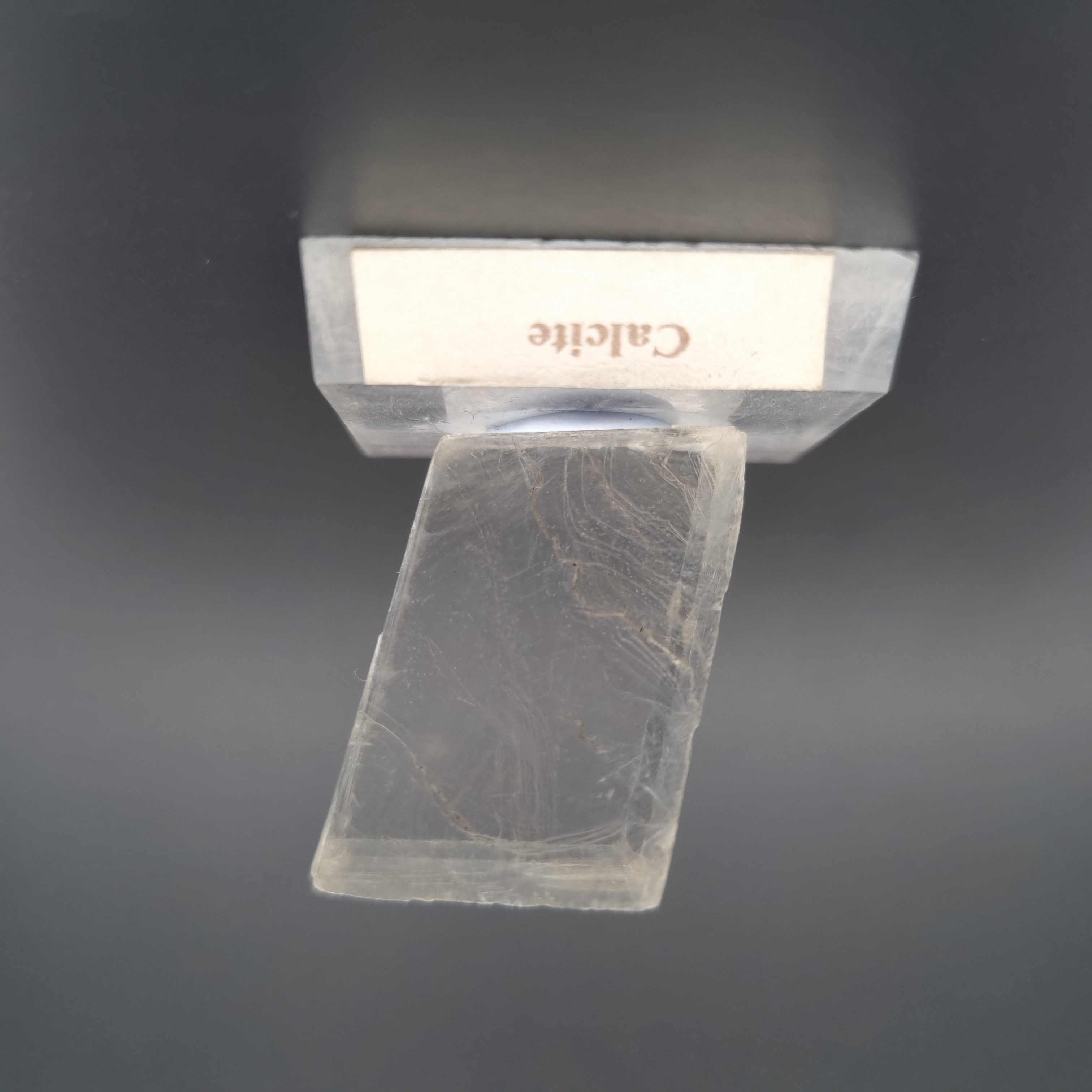 |
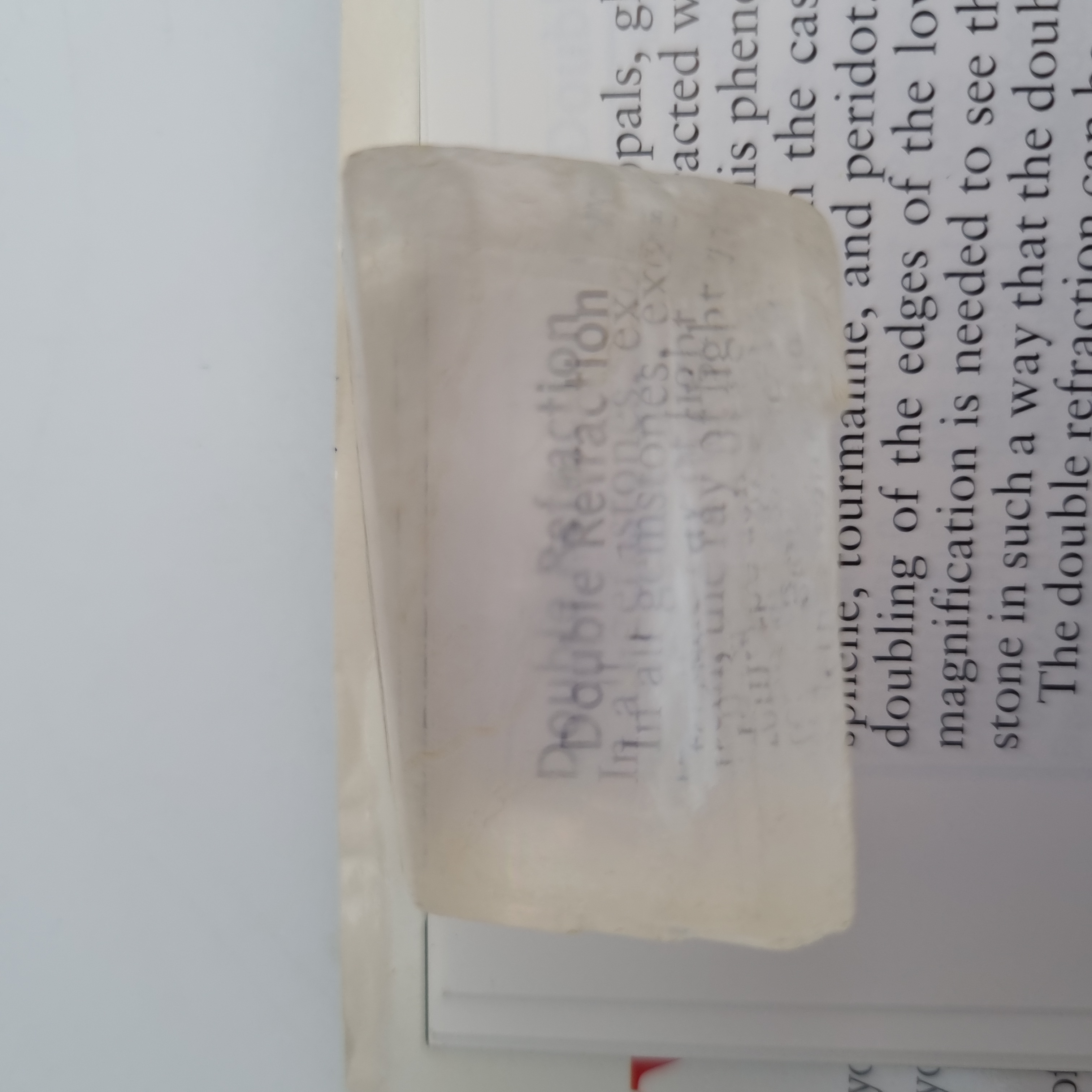 |
| A colourless and transparent calcite specimen. |
When placed over some words, the transparent calcite specimen splits up the light waves to produce “doubling effect”. This phenomenon is described as “double refraction” too. |
Danburite is named after the first discovery in Danbury, Connecticut. It can be faceted well because of its hardness (7 to 7.5) and does not cleave easily. It is a mineral with chemical composition of calcium boric silicate.
 |
 |
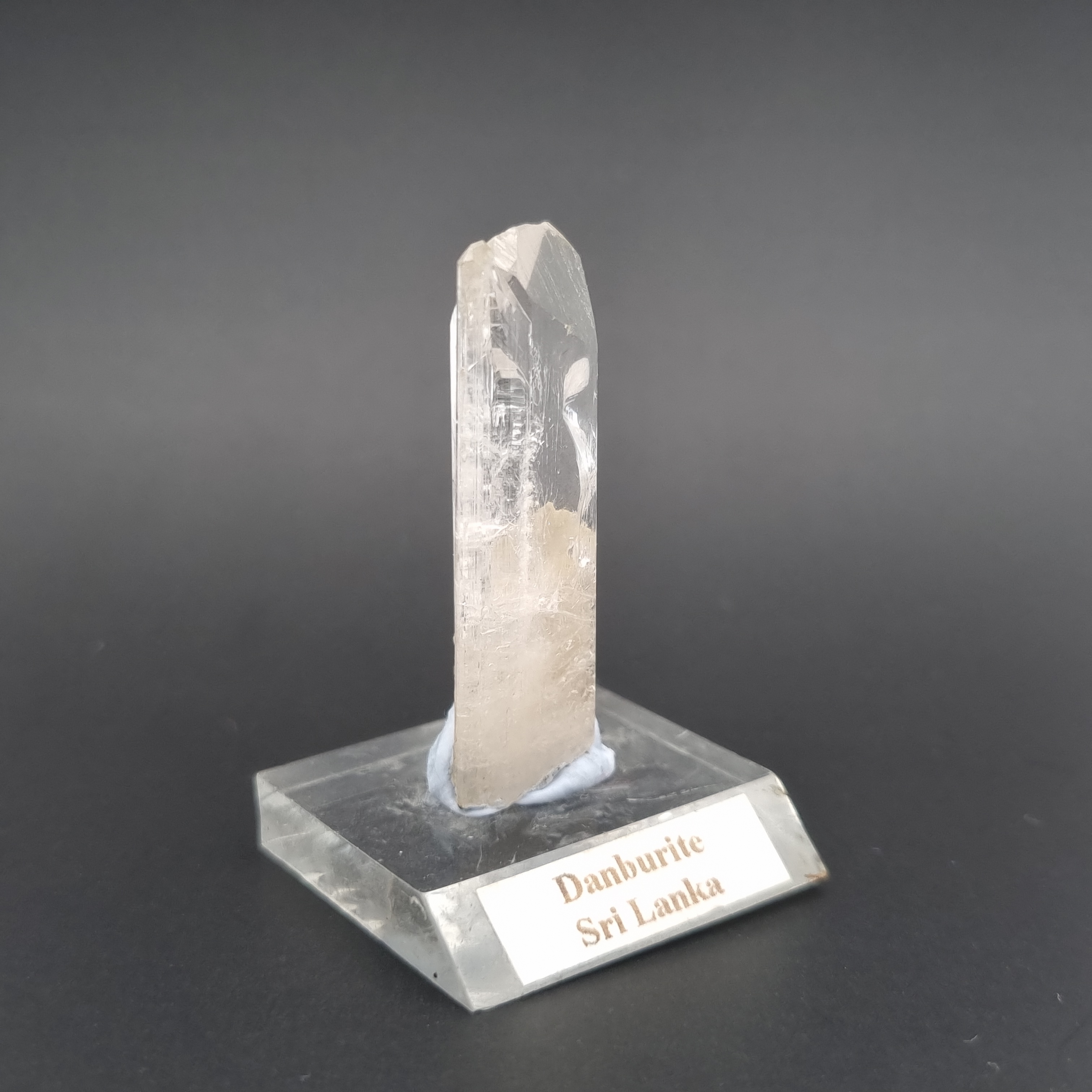 |
| A danburite crystal from Sri Lanka viewed from different angles. Its crystal habit is described as orthorhombic, prismatic. | ||
Perhaps in time to come, some of these gems will succeed diamonds as diamonds become more of a commodity? Would that be possible? Maybe we will leave this thought with you for now.
Acknowledgments:
Far East Gem Institute for the photos and specimens.
The Gem Museum for the mineral specimens.
